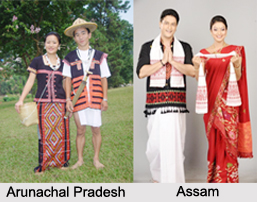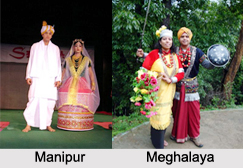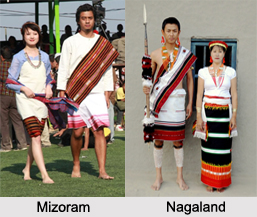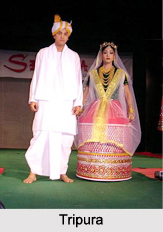 Traditional Dresses of North East Indian States gives an identity to the Asian fashion worldwide. North East region of India consists of the eight states namely Arunachal Pradesh, Assam, Meghalaya, Manipur, Mizoram, Nagaland, Tripura and Sikkim. Along with the scenic beauty of North East India, its traditional ethnic clothes represent the true spirit of India. These North East Indian States have beautiful and very unique culture, traditions and lifestyle. There are many tribes here and each have a distinct pattern of clothing. People of these states have different traditional dresses and costumes, which only can be explored during the fair and festival season. The real culture and traditions of these States are still alive and followed by the young generation.
Traditional Dresses of North East Indian States gives an identity to the Asian fashion worldwide. North East region of India consists of the eight states namely Arunachal Pradesh, Assam, Meghalaya, Manipur, Mizoram, Nagaland, Tripura and Sikkim. Along with the scenic beauty of North East India, its traditional ethnic clothes represent the true spirit of India. These North East Indian States have beautiful and very unique culture, traditions and lifestyle. There are many tribes here and each have a distinct pattern of clothing. People of these states have different traditional dresses and costumes, which only can be explored during the fair and festival season. The real culture and traditions of these States are still alive and followed by the young generation.
Traditional Dress of Arunachal Pradesh
The women of Arunachal Pradesh wear vibrant coloured dresses with intricate patterns made of threads and unique patterns that reflect the culture of the tribes they belong to. Their dresses are commonly adorned with fine beads or silver jewellery.
While the people of some tribes use a jacket above a sleeveless chemise tied to their waist with a lengthy and narrow strip of cloth, others wear a sleeveless and collarless robe stretching from the shoulders to the knees. Accessories are an important part of the costume in Arunachal Pradesh. "Gurdam", a skull cap filled with Yak hair, is worn to complete the look during important occasions.
 Traditional Dresses of Assam
Traditional Dresses of Assam
Assam is famous for its Muga and Pat silk sarees and Mekhla Chador, worn on special occasions. Mekhla Chador is very similar to a half-saree of South India. There are many tribes in Assam, each with its own distinct and unique style of Mekhla Chador, distinguished by motifs, design and colours. The women of Dimasa tribe wear a skirt-like clothing which is called "Rigu" and an embellished vest-like attire called "Rijamphai", sometimes also known as "Rikhaosa".
Most Assamese women also wear traditional jewellery like "Gaam Kharu" which are large silver bangles, "Kopo Phool" earrings and "Mukuta Moni" necklaces, unique and charming pieces that add to the charm of one"s attire.
Traditional Dresses of Manipur
"Phanek", a wrap-around skirt or "Sarong", a stiff skirt, constitute the traditional clothing of a Manipuri girl, which she wears with pride and grace. The women of Manipur also wear a saree-like cloth, called "Moirang Phi". Different tribes of Manipur have their own distinctive dresses like "Lmaphie", "Saijounba", "Ningthoupee" and "Phiranji".
Traditional Dresses of Meghalaya
Meghalaya is the home to the three famous hill tribes of India – Khasi, Jaintias and Garos. The women from the Garo, Jaintia, and Khasi tribes of Meghalaya look elegant in their traditional wear.
 A Khasi woman commonly wears an ankle-length costume with a fitted blouse over it, called "Jainsen". They also wear chequered cotton shawls over the blouse, called "Tap-Moh Khlieh".
A Khasi woman commonly wears an ankle-length costume with a fitted blouse over it, called "Jainsen". They also wear chequered cotton shawls over the blouse, called "Tap-Moh Khlieh".
Garo women usually drape an unstitched garment, woven out of mulberry silk. They are also seen wearing "Eri" silk shawls, as well as a blouse and an unstitched cloth called "Dakmanda", on the lower half of their body. The Dakmanda has a thick border, and is often decorated with motifs and floral patterns.
The women of the Jaintia tribe are seen wearing a sarong called "Thoh Khyrwang", with a velvet blouse. A long piece of Muga silk is tied around their shoulders, flowing down to their ankles. They also often wear a very elegant headpiece known as "Kyrshah".
Traditional Dresses of Mizoram
There are many traditional dresses of Mizo women. A Mizo women dresses elegantly in full-sleeved dresses, the most common among them are a three-piece Churidar-kurta-dupatta set, called "Puan". Apart from this, a long, chequered skirt is worn with a colourful shirt, called "Puanchei", on important occasions like weddings or festivals. These long skirts have vertical embroidery in colourful threads, which make them look quite attractive. Mizo women are also seen sporting beautiful headgear made of brass and colourful cane, decorated with items like porcupine quills and parrot feathers.
 Traditional Dresses of Nagaland
Traditional Dresses of Nagaland
The Naga shawls form an important part of the culture and attire of the people here. Often, shawls are considered as a badge of honour, and are gifted to aged and experienced people.
Women in Nagaland are seen dressed in skirts which are, again, different from one tribe to another, and are known by different names as well. Some of the popular types of Ao skirts include "Azu Jangnup Su" with red and yellow-black stripes; "Ngami Su" is a fish tail skirt and "Yongzujangau" is a cucumber seed skirt which is woven in red threads on a black base. The women of the Angami tribe wear sleeveless tops called "Vatchi" over a white skirt called "Pfemhou" and a petticoat called "Neikhro".
Traditional Dresses of Sikkim
The clothing of Sikkim shows this diversity and exemplifies social and cultural lives of the three main resident communities – the Lepchas, Bhutias and the Nepalis. The "Thokro-Dum" is the primary outfit for the male members of the Lepcha community. The traditional attire of Lepcha women involves a saree-like garment known as "Dumvum". The traditional dress donned by Bhutias is the "Bakhu" which is worn by both men and women. Nepali males love to wear "Shurval", which is a Pyjama with a shirt a traditional shirt.
Traditional Dresses of Tripura
A beautifully woven two-piece called "Rinai" and "Risa" is worn by the women here. The "Rinai" is wrapped around the waist, while the "Risa" is worn on the upper part of the body. These dresses are commonly paired with beautiful traditional jewellery, adding to their charm.





















